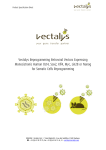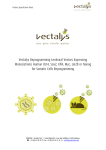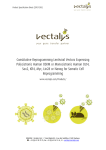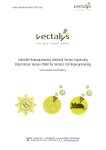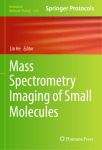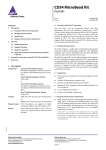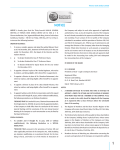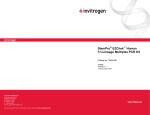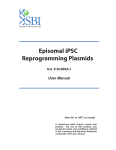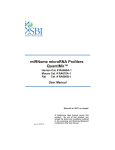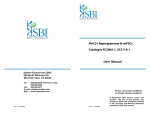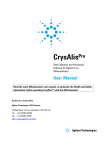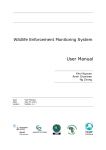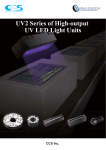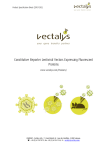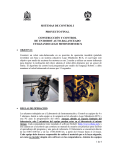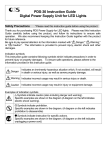Download Vectalys Reprogramming Lentiviral Vectors Expressing Polycistronic
Transcript
Product Specification Sheet Vectalys Reprogramming Lentiviral Vectors Expressing Polycistronic Human OSKM for Somatic Cells Reprogramming COMPANY : Vectalys SAS, Canal Biotech II, 3 rue des Satellites, 31400 Toulouse. : +33 (5) 61 28 70 75, fax: +33 (5) 62 26 12 44, : [email protected] Product Specification Sheet Vectalys Reprogramming Lentiviral Vectors: Human OSKM Catalog Number referring to this User Manual: iL OSKM-7; iL OSKM-7P; il OSKM-9 Contents (according to your particular Cat.#): Cat.# iL OSKM-7: 10x100µl of Oct4, Sox2, KLF4, and Myc polycistronic lentiviral vectors. Cat.# iL OSKM-7P: 1x100µl of Oct4, Sox2, KLF4, and Myc polycistronic lentiviral vectors. Cat.# iL OSKM-9: 5x20µl of Oct4, Sox2, KLF4, and Myc polycistronic lentiviral vectors. Please refer to the certificate of Analysis (CoA) for the titer of your particular lot. Introduction: Induced Pluripotent Stem (iPS) cells were first obtained by S. Yamanaka in 2006 using adult mouse fibroblasts with expression of a select group of transcription factors. IPS cells were then obtained from human fibroblasts in 2007. Reprogramming has been achieved in many instances by the co-transduction of the four Yamanaka transcription factors: Oct4, Sox2, Klf4, and c-Myc (OSKM), in four individual expression vectors. Successful dedifferentiation requires that a sufficient number of each viral vector deliver the four factors simultaneously to the same cell. In many ways, iPS cells are similar to embryonic stem (ES) cells but iPS cells exhibit an undeniable ethical advantage, compared to ES cells 1-4. Vectalys provides highly purified & concentrated polycistronic lentiviral vectors carrying all four expression factors separated by self-cleaving 2A peptide sequences. Thereby, such a single polycistronic cassette enables: the whole set of factors to be integrated into the same integration site the decrease of the M.O.I. (and therefore the viral charge) applied to the cells during the transduction allowing better quality iPS cells and safer downstream reprogramming process for disease model and clinical therapies. Product Description: The Vectalys Reprogramming Lentiviral Vectors: Human OSKM includes hOct4, hSox2, hKLF4, and hcMyc as prepackaged lentiviral particles for reprogramming human somatic cells. These VSV-G pseudotyped viruses are capable of infecting both dividing and non-dividing cells. The high purification level of those lentiviral particles allows to transduce primary cells and immortalized cell lines without inducing any toxicity effects to the cells, and thus even at high multiplicity of infection (M.O.I.). The expression of these four factors has been shown to direct a variety of differentiated cells into induced pluripotent stem (iPS) cells with embryonic stem (ES) cell-like properties. Handling and Storage : Store at -80°C. Keep frozen until use. Avoid freeze thaw cycles. The use of gloves and disposable lab coats while working with viral derived vectors is strongly recommended. This product must only be handled into a biosafety cabinet under BSL-2 controls. Lentiviral vectors are stable for at least 1 year after receipt when stored at -80°C. After first thaw, place immediately on ice (in any cases, please refer to the thawing protocol included into this document). The viral vectors are packaged in a working aliquots and only one freeze-thaw cycle is required before use. In case that more than one freeze-thaw cycle are required according to your applications, Vectalys recommend to apply a decrease of about 15% in viral vectors titer for each freeze-thaw cycles. This product is distributed for research use only. It is not for use in diagnostic procedures as the safety and efficacy of this product in diagnostic or other clinical COMPANY : Vectalys SAS, Canal Biotech II, 3 rue des Satellites, 31400 Toulouse. : +33 (5) 61 28 70 75, fax: +33 (5) 62 26 12 44, : [email protected] Product Specification Sheet uses has not been established. The use of lentiviral derived vectors implies to follow laboratory biosafety procedures and practices in agreement with your country regulations. SYMBOL : CLASSIFICATION : Biorisk class C2L2 Safety precautions: The greatest safety risk associated with viral delivery systems comes from the potential generation of recombinant viruses that are capable of autonomous replication during the packaging process. The Vectalys Reprogramming Lentivirus platform eliminates these hazards by combining a disabled viral genome with a unique manufacturing process. Also, gene functions that facilitate the enclosing of the silencing sequence in a viral capsid (e.g., Gag, Pol, Env) are distributed into multiple helper plasmids (which do not contain significant regions of homology) during packaging. This method further minimizes the probability of recombination events that might otherwise generate viruses capable of autonomous replication. With these safety measures in place, the Vectalys Reprogramming Lentivirus particles can be employed in standard Biosafety Level 2 tissue culture facilities and should be treated with the same level of caution as with any other potentially infectious agent. Also, please note that the c-Myc and Klf4 proteins are reported to demonstrate oncogenic properties. Quality controls: The several controls applied to the Vectalys Reprogramming Lentiviral Vectors are of different types: the viral vectors are tittered in efficient transduction units. Viral integration copy number was quantified by transduction of mammalian cells followed by qPCR of the genomic DNA. the viral vectors are as well, tittered in physical particles using an ELISA assay. the specific activities, according to DNA and proteins impurities, are measured The residual DNA and total proteins are quantified using commercial kits. the potential generation of replication-competent viruses is tested according to an RCL assay. These controls are performed since Vectalys demonstrated the negative impact of residuals DNA and Proteins impurities on cellular toxicity after transduction. Transcription factor protein expression was verified by immunocytochemistry analysis of transduced mammalian cells. Reprogramming was verified by transduction of human fibroblasts, generation of iPS cell colonies, and subsequent colony characterization by immunocytochemistry. Tested to be negative for Mycoplasma sp. by luminometry. Directions for use, thawing protocol: When applicable, the vectors should be taken out of the freezer -80°C at the last moment. Once thawed, the vectors should be used for transduction as soon as possible to avoid degradation. In any case, it is essential avoiding thermal shock to the cells and vectors. If the vectors should be diluted in medium, use a medium at room temperature to minimize the heat shock experienced by the vectors and the cells. Just before the transduction, take out the tubes of viral supernatant of the -80°C freezer and thaw them on ice at 4°C. 5 min before transduction take out the tubes of the ice and allow to warm-up at room temperature. COMPANY : Vectalys SAS, Canal Biotech II, 3 rue des Satellites, 31400 Toulouse. : +33 (5) 61 28 70 75, fax: +33 (5) 62 26 12 44, : [email protected] Product Specification Sheet Directions for use, Materials Required but Not Provided: 1. 2. 3. 4. 5. 6-well plates (TC grade) Cell counter / hemocytometer Complete media FBS supplemented Phosphate Buffered Saline (PBS) Polybrene® (Hexadimethrine bromide – Sigma: 107689-10G) Directions for use, Transduction Protocol for Human Somatic cells: The following protocol has been optimized using early passage human foreskin fibroblasts. This protocol allowed us to transduce human foreskin fibroblast cells with a transduction efficiency of 100%. The following protocol is a working basis and should only be used as a reference to optimize conditions that will enable the generation of iPS cells from other human target cells. The pre-transduction seeding and cells quantity to be transduced can be modified according to the needs. The multiplicity of infection (M.O.I.), the time of viral vectors incubation on cells and the Polybrene® concentration are critical points that must strictly be followed. Day 0: Cells seeding Seed the cells by plating out from 1x104 to 5x104 cells per well of a 6-well plate according to the cell type you are using. Culture medium should be the same as that used to maintain target cells in proliferative state. The maximum volume per well of a 6-well plate should be 4ml. Incubate overnight in a 37°C, 5% CO2 incubator. A control well must be set aside for counting the number of cells on the day of transduction. Day1: Transduction A) Count the number of cells in your control well of the 6-well plate. The control well is used to settle the right viral vectors quantity needed to achieve a target M.O.I. and to keep constant the M.O.I. from an experiment to another. B) Using the following equation, determine the right volume of viral vectors required to achieve an adviced M.O.I. of 5. Please pay attention to the lot titer as it may vary by lot: Viral vectors volume required (µl) = Number of cells seeded x M.O.I. x 1000 Viral Vectors Titer (TU/ml) C) Thaw the requisite amount of rLV-EF1-OSKM lentiviral vectors according to the thawing protocol mentioned above. The viral supernatant has to be homogenized by pipeting up and down and not by inverting upside down the vial. D) Prepare the transduction mix by adding the required volume of thawed viral particles to the complete media previously supplemented by 20µl of Polybrene® (800µg/ml). The final volume should be 4ml maximum for a transduction in a 6-well plate. E) Discard the medium from each well and replace it by adding the transduction mix on the cells (be careful to apply the transduction mix on well edges, to avoid any cell disruption). Gently rock the plate from side to side to mix the viral vectors onto the target cells. COMPANY : Vectalys SAS, Canal Biotech II, 3 rue des Satellites, 31400 Toulouse. : +33 (5) 61 28 70 75, fax: +33 (5) 62 26 12 44, : [email protected] Product Specification Sheet F) Incubate the plate 5h in a 37°C, 5% CO2 incubator. G) After 5 hours incubation, discard the transduction mix and wash the cells once with 3ml 1x PBS per well. Then, discard the PBS and replace it by 4ml of complete media. If necessary, perform a second transduction by repeating the steps described above. A second transduction must not be performed before 48h after the first transduction. References: 1. 2. 3. 4. Rashid S. T, Corbineau S, Hannan N, Marciniak S.J, Miranda E, Alexander G, Huang-Doran I, Griffin J, Ahrlund-Richter L, Skepper J, Semple R, Weber A, Lomas D. A, Vallier L. Modeling inherited metabolic disorders of the liver using human induced pluripotent stem cells. J Clin Invest., 2010, 120 (9), 3127-3136. Lapillonne H, Kobari L, Mazurier C, Tropel P, Giarratana M-C, Zanella-Cleon I, Kiger L, Wattenhofer-Donze M, Puccio H, Hebert N, Francina A, Andreu G, Viville S, and Douay L. Red blood cells generation from human induced pluripotent stem cells: perspectives for transfusion medicine. Haematologica. 2010, 95 (10), 1651-1659. Banito A, Rashid ST, Acosta JC, Li S, Pereira CF, Geti I, Pinho S, Silva JC, Azuara V, Walsh M, Vallier L, Gil J. Senescence impairs successful reprogramming to pluripotent stem cells. Genes Dev., 2009, 23: 2134-2139. Vallier L, Touboul T, Brown S, Cho C, Bilican B, Alexander M, Cedervall J, Chandran S, Ährlund-Richter L, Weber A, Pedersen R.A. Signaling pathways controlling pluripotency and early cell fate decisions of human induced pluripotent stem cells. Stem cells, 2009, 27 (11) : 2655-2666. Notice to purchaser: Purchaser represents and warrants that it will use the Vectalys Reprogramming Lentiviral Vectors: Human OSKM purely for research purposes, not for diagnostic use, not for resale, and not for use in humans or veterinary applications. Vectalys will not be held responsible for patent infringement or other violations that may occur with the use of our products. Purchaser must determine the suitability of the product(s) for their particular use. Additional terms and conditions may apply. End user notice: 1. END USER shall not use the LICENSED PRODUCTS, iPSCs generated by use of the LICENSED PRODUCT or derivatives thereof for uses other than for END USER’s internal research use in the END USER FIELD OF USE. 2. END USER FIELD OF USE means noncommercial internal research use only. END USER FIELD OF USE excludes research involving application and use of LICENSED PRODUCTS, iPSCs generated by use of the LICENSED PRODUCT or derivatives thereof for human/animal therapeutic, diagnostic and/or prophylactic purposes. END USER FIELD OF USE also excludes research for Commercial Purpose. “Commercial Purpose” shall mean any activity by an END USER including at least one of following activities: (i) use of the LICENSED PRODUCTS or components of vectors, or iPSCs generated by use of the LICENSED PRODUCT or derivatives thereof for development, or manufacture of related products including but not limited to culture medium and equipment, (ii) use of the LICENSED PRODUCTS or components of vectors, or iPSCs generated by use of the LICENSED PRODUCT or derivatives thereof to provide a service, information or data to a third party, and COMPANY : Vectalys SAS, Canal Biotech II, 3 rue des Satellites, 31400 Toulouse. : +33 (5) 61 28 70 75, fax: +33 (5) 62 26 12 44, : [email protected] Product Specification Sheet (iii) use of the LICENSED PRODUCTS or components of vectors, or iPSCs generated by use of the LICENSED PRODUCT or derivatives thereof for screening compounds, antibodies, proteins, peptides and the other as potential pharmaceutical compounds. For the avoidance of doubts, any type of joint development between non-commercial organization and commercial organization is considered as an internal use for “Commercial Purposes.” 3. If END USER wishes to use the LICENSED PRODUCTS, or iPSCs generated by use of the LICENSED PRODUCT or derivatives thereof in the END USER FIELD OF USE for Commercial Purpose, END USER notifies: iPS Academia Japan, Inc. Kameya-cho, Kawaramachi Higashi-iru, Kojinguchi-dori Kamigyo-ku, Kyoto 602-0854 JAPAN to the attention of, ATTN: Vice President, License for such use, and then shall negotiate for a license from iPS Academia, Japan Inc. to use the LICENSED PRODUCTS, iPSCs generated by use of the LICENSED PRODUCT or derivatives with iPS Academia Japan, Inc. and agree to take a required license. 4. END USER shall not transfer, sell or supply any LICENSED PRODUCTS, or iPSCs generated by use of the LICENSED PRODUCT or derivatives thereof to any third parties. 5. END USER shall not use the LICENSED PRODUCTS, or iPSCs generated by use of the LICENSED PRODUCT or derivatives thereof, for application and use for human/animal therapeutic, diagnostic and or prophylactic purposes. 6. No other right, express or implied, is conveyed by the sale of the LICENSED PRODUCTS or the rendering of the LICENSED SERVICES. COMPANY : Vectalys SAS, Canal Biotech II, 3 rue des Satellites, 31400 Toulouse. : +33 (5) 61 28 70 75, fax: +33 (5) 62 26 12 44, : [email protected]







